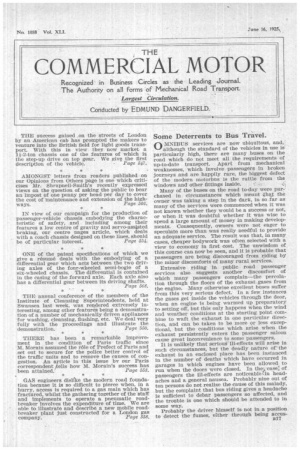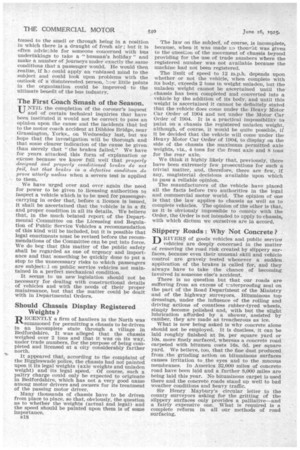Some Deterrents to Bus Travel.
Page 1

Page 2

If you've noticed an error in this article please click here to report it so we can fix it.
MNIBUS services are now ubiquitous, and, although the standard of the vehicles in use is particularly high, there are many buses on the road which do not meet all the requirements of up-to-date transport. Apart from mechanical weaknesses, which involve passengers in broken journeys and are happily rare, the biggest defect of the modern motorbus is the rattle from the windows and other fittings inside.
Many of the buses on the road to-day were purchased in circumstances which meant that the owner was taking a step in the dark, in so far as many of the services were commenced when it was not known whether they would be a success or not, or when it was doubtful whether it was wise to spend a large amount of money in making developments. Consequently, owners were not eager to speculate more than was really needful to provide an adequate service. The result was that, in many cases, cheaper bodywork was often selected with a view to economy in first cost. The unwisdom of• this course can now be seen, and it is probable that• passengers are being discouraged from riding by the minor discomforts of many rural services.
Extensive riding in public road passenger services also suggests another discomfort of which many passengers complain—the percolation through the floors of the exhaust gases from the engine. Many otherwise excellent buses suffer from this very serious defect. In a few instances the gases get inside the vehicles through the door, when an engine is being warmed up preparatory to setting off, but this only happens when the wind and weather conditions at the starting point combine to waft the exhaust in one particular direction, and can be taken to be more or less exceptional, but the conditions which arise when the exhaust persistently enters the passenger saloon cause great inconvenience to some passengers.
It is unlikely that serious ill-effects will arise in such circumstances, but the deadly nature of' the exhaust in an enclosed place has been instanced in the number of deaths which have occurred in garages in which engines have been allowed to run when the doors were closed. In thel:casel of passengers the ill-effects are noticeable■Tin headaches and a general nausea. Probably nine out of ten persons do not realize the cause of this malady, but the complaint that bus riding gives a headache Is sufficient to debar passengers so affected, and the trouble is one which should be attended to in some way.
Probably the driver himself is not in a position to detect the fumes, either through being accus 'Mined to the smell or through being in a position in which there is a draught of fresh air; but it is often adviszble for someone concerned with bus undertakings to take a "busman's holiday" and make a number of journeys under exactly the same conditions that a passenger would. He would then realize, if hr: could apply an enblased mind to the subject and could look upon problems with the outlook of a disinterested, person, how little points in the organization could be improved to the ultimate benefit of the bus industry.
The First Coach Smash of the Season.
UNTIL the completion of the coroner's inquest and of certain technical inquiries that have been instituted it would not be correct to pass an opinion upon the cause and the incidents that led to the motor coach accident at Dibbles Bridge, near Grassingten, Yorks,, on Wednesday last, but we hope that the investigation will be thorough and that some clearer indication of the cause be given. thanmerely that "the brakes failed." We have for years attacked this form of explanation or excuse because we know full well that properly designed and properly conditioned brakes do not fail, but that brakes in. a defective condition, do prove utterly useless when a severe test is applied to them.
We have urged over and over again the need for power to be given to licensing authorities to inspect a vehicle which is to be used for passengercarrying in order that, before a licence is issued, It shall be ascertained that the vehicle is in a fit and proper condition in all its details. We believe that, in the much belated report of the Departmental Committee on the Licensing and Regulation of Public Service Vehicles a recommendation of this kind will be included, but it is possible that legal enactments must be revised before the recommendations of the Committee can be put into force. We do beg that this matter of the public safety shall be regarded as one of urgency and importance and that something be quickly done to put a stop• to the unnecessary risks to which passengers are subjecti on public service vehicles not maintained in a perfect mechanical condition. It seems to us new legislation should not be necessary for dealing with constructional details of vehicles and with the• needs of their proper maintenance, but that the matter could he dealt with in Departmental Orders.
Should Chassis Display Registered Weights ?
RECENTLY a firm of hauliers in the North was -106-summoned for permitting a chassis to be driven In an incomplete state through a village in Bedfordshire. It was alleged that the chassis weighed over 2 tons and that it was on its way, under trade numbers, for the purpose of being completed and licensed at a city considerably farther north.
It appeared that, according to the complaint of the Biggleswade police, the chassis had not painted upon it its legal weights (axle weights and unladen weight) and its legal speed.Of course, such a paltry charge could only be expected to originate in Bedfordshire, which has not a very good name among motor drivers and owners for its treatment of the passing motor driver. Many thousands of chassis have to be driven from place to place, so that, obviously, the question as to whether the weights (actual and legal) and the speed should be painted upon them is of some importance.
B18 The law on the subject, of course, is incomplete, because, when it was made no thouo#11t was given to the ouestion of the movement of chassis beyond providing for the use of trade numbers where the registered number was not available because the machine had not been registered.
The limit of speed to 12 m.p.h, depends upon whether or not the vehicle, when complete with its body, exceeds 2 tons in weight unladen, but the unladen weight cannot be ascertained until the chassis has been completed and converted into a vehicle by the addition of its body, and until this weight is ascertained it cannot be definitely stated that the vehicle does come under the Heavy Motor Car Order of 1904 and not under the Motor Car Order of 1904. It is a practical impossibility to paint on a chassis the registered unladen weight, although, of course, it would be quite possible, if it be decided that the vehicle will come under the Heavy Motor Car Order of 1904, to display on the side of the chassis the maximum permitted axle weights, viz., 4 tons for the front axle and 8 tons for the rear axle.
We think it highly likely that, previously, there have been extremely few prosecutions for such a trivial matter, and, therefore, there are few, if any, magisterial decisions available upon which to pass a reliable opinion. The manufacturers of the vehicle have placed all the facts before two authorities in the legal and commercial motor world. The opinion of one is that the law applies to chassis as well as to complete vehicles. The opinion of the other is that, as it is obviously impossible to cornnly with the Order, the Order is not intended to apply to chassis, with which dictum we ourselves are in accord.
Slippery Roads : Why Not Concrete ?
DRIVERS of goods vehicles and public service vehicles are deeply concerned in the matter of removing the road risk created by slippery surfaces, because even their unusual skill and vehicle control are gravely tested whenever a sudden application of the brakes is called for, and they always have to take the chance of becoming involved in someone else's accident.
There is no question but that our roads are suffering from an excess of -waterproofing zeal on the part of the Road DepartMent of the Ministry and of the highway surveyors. Bituminous top dressings, under the influence of the rolling and driving actions of countless rubber-tyred wheels, simply become polished and, with but the slight lubrication afforded by a shower, assisted by camber, they are made as treacherous as ice. What is now being asked is why concrete alone should not be employed. It is dustless, it can be laid roughly finished at 9s. per square yard or 10s. more finely surfaced, whereas a concrete road carpeted with bitumen costs 16s. ed. per square yard. We believe, too, that the fine dust produced• from the grinding action on bituminous surfaces causes irritation to _the eyes and to the mucous membranes. In America 32,000 miles of concrete road have been laid and a further 8,000 miles are being laid this year. No bituminous carpet is used there and the concrete roads stand up well to bad weather conditions and heavy traffic. Sir Henry Maybury's circular letter to the county surveyors asking for the gritting of the slippery surfaces only provides a palliative—and a fairly expensive one. What is required is a complete reform in all our methods of road surfacing.






























